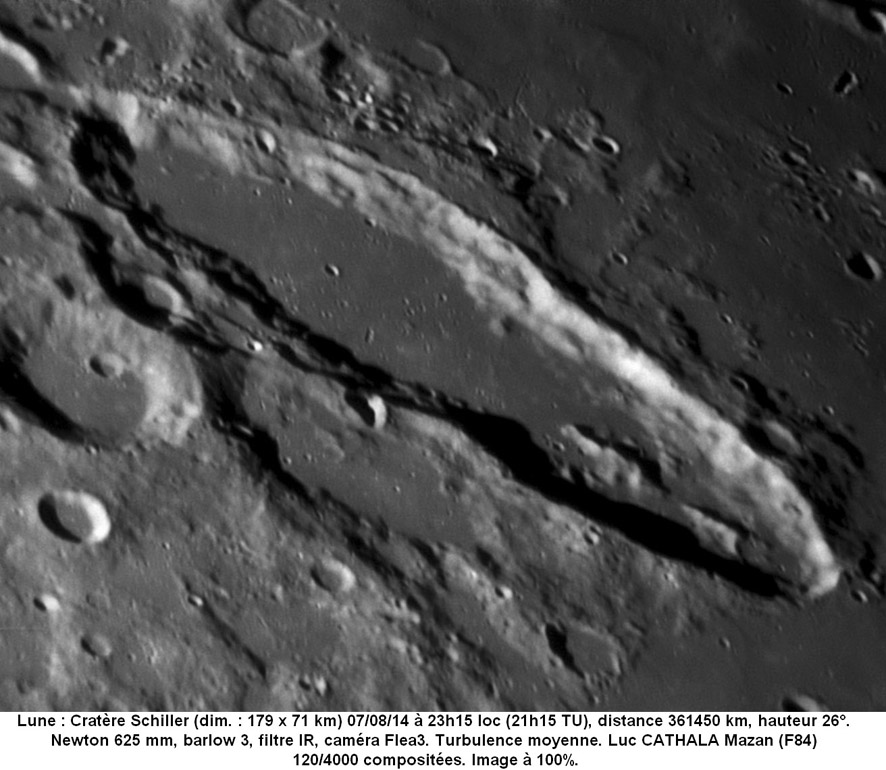Difference between revisions of "August 10, 2014"
| Line 1: | Line 1: | ||
__NOTOC__ | __NOTOC__ | ||
=Either Or= | =Either Or= | ||
| − | |||
<!-- ws:start:WikiTextHeadingRule:0:<h1> --> | <!-- ws:start:WikiTextHeadingRule:0:<h1> --> | ||
<!-- ws:start:WikiTextLocalImageRule:6:<img src="/file/view/LPOD-Aug10-14.jpg/518126096/LPOD-Aug10-14.jpg" alt="" title="" /> -->[[File:LPOD-Aug10-14.jpg|LPOD-Aug10-14.jpg]]<!-- ws:end:WikiTextLocalImageRule:6 --><br /> | <!-- ws:start:WikiTextLocalImageRule:6:<img src="/file/view/LPOD-Aug10-14.jpg/518126096/LPOD-Aug10-14.jpg" alt="" title="" /> -->[[File:LPOD-Aug10-14.jpg|LPOD-Aug10-14.jpg]]<!-- ws:end:WikiTextLocalImageRule:6 --><br /> | ||
| − | <em>image by [mailto:luccat@sfr.fr Luc CATHALA Mazan], Vaucluse FRANCE</em><br /> | + | <em>image by [mailto:luccat@sfr.fr" rel="nofollow Luc CATHALA Mazan], Vaucluse FRANCE</em><br /> |
<br /> | <br /> | ||
| − | Schiller was formed by a simultaneous grazing impact of three or four projectiles. The individual crater widths range from about 50 to 70 km. According to [http://pirlwww.lpl.arizona.edu/~jmelosh/crater_p.cgi calculations], craters this size would have required projectiles 5 to 7 km in diameter if the impact angle was 5°, and double that size if 1°. Assuming 5°, the four separate 6 km wide projectiles before break up could have been a 12 km diameter projectile which, with 90° impact, would have made a single crater 300 km wide. If Schiller's impact angle were 1° the equivalent single crater would have been about 500 km wide. If my calculations are correct - someone should check! - then Schiller is the bizarre replacement for a small impact basin, about the size of the outer ring diameter of Grimaldi. Even though basins are fascinating I guess I am glad we have Schiller instead.<br /> | + | Schiller was formed by a simultaneous grazing impact of three or four projectiles. The individual crater widths range from about 50 to 70 km. According to [http://pirlwww.lpl.arizona.edu/~jmelosh/crater_p.cgi" rel="nofollow calculations], craters this size would have required projectiles 5 to 7 km in diameter if the impact angle was 5°, and double that size if 1°. Assuming 5°, the four separate 6 km wide projectiles before break up could have been a 12 km diameter projectile which, with 90° impact, would have made a single crater 300 km wide. If Schiller's impact angle were 1° the equivalent single crater would have been about 500 km wide. If my calculations are correct - someone should check! - then Schiller is the bizarre replacement for a small impact basin, about the size of the outer ring diameter of Grimaldi. Even though basins are fascinating I guess I am glad we have Schiller instead.<br /> |
<br /> | <br /> | ||
| − | <em>[mailto:tychocrater@yahoo.com Chuck Wood]</em><br /> | + | <em>[mailto:tychocrater@yahoo.com" rel="nofollow Chuck Wood]</em><br /> |
<br /> | <br /> | ||
<strong>Technical Details</strong><br /> | <strong>Technical Details</strong><br /> | ||
| Line 15: | Line 14: | ||
<strong>Related Links</strong><br /> | <strong>Related Links</strong><br /> | ||
<em>[http://lpod.wikispaces.com/21st+Century+Atlas+of+the+Moon 21st Century Atlas]</em> chart 24.<br /> | <em>[http://lpod.wikispaces.com/21st+Century+Atlas+of+the+Moon 21st Century Atlas]</em> chart 24.<br /> | ||
| − | Luc's [http://www.astrobin.com/users/CATHALA.Luc.CATLUC/ website]<br /> | + | Luc's [http://www.astrobin.com/users/CATHALA.Luc.CATLUC/" rel="nofollow website]<br /> |
<br /> | <br /> | ||
<hr /> | <hr /> | ||
Revision as of 23:02, 4 January 2015
Either Or

image by " rel="nofollow Luc CATHALA Mazan, Vaucluse FRANCE
Schiller was formed by a simultaneous grazing impact of three or four projectiles. The individual crater widths range from about 50 to 70 km. According to " rel="nofollow calculations, craters this size would have required projectiles 5 to 7 km in diameter if the impact angle was 5°, and double that size if 1°. Assuming 5°, the four separate 6 km wide projectiles before break up could have been a 12 km diameter projectile which, with 90° impact, would have made a single crater 300 km wide. If Schiller's impact angle were 1° the equivalent single crater would have been about 500 km wide. If my calculations are correct - someone should check! - then Schiller is the bizarre replacement for a small impact basin, about the size of the outer ring diameter of Grimaldi. Even though basins are fascinating I guess I am glad we have Schiller instead.
" rel="nofollow Chuck Wood
Technical Details
August 7 2014, 21h15 UT. Newton 625 mm, 2739mm focal length, on equatorial platform, all home made (excluding mirrors ). Barlow 3 , IR 742 filter, camera Flea3, average turbulence.120 images stacked on 3250. Processed with AutoStakker, Registax.
Related Links
21st Century Atlas chart 24.
Luc's " rel="nofollow website



